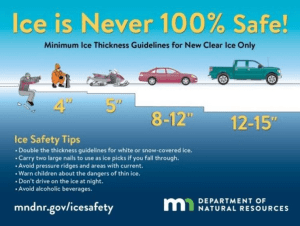Ice Safety
Ice Safety For Ice Fishing
It’s important to know basic ice safety in order to maximize ice fishing safety and enjoy your winter fishing outing.
- Booming & cracking ice isn’t necessarily dangerous. This happens when ice is expanding and contracting as the temperature changes.
- New ice is generally stronger than old ice. Four inches of clear, newly formed ice may support one person on foot, while a foot or more of old, partially thawed ice may not.
- Ice seldom freezes uniformly. It may be 1 foot thick in one location and only an inch or two just a few feet away.
- Ice that is formed overflowing water and currents is often dangerous. Especially near streams, bridges, and culverts. Also, the ice outside river bends is usually weaker, due to the undermining effects of a fast current.
- It’s important to note that schools of fish or flocks of waterfowl can affect the relative safety of ice. The movement of fish can bring warm water up from the bottom of the lake, causing holes in the ice.
- The insulating effect of snow slows down the freezing process. The extra weight also reduces how much weight the ice sheet can support. Also, ice near shore can be weaker than ice that is farther out.
Checking The Ice
A spud bar/chisel isn’t meant to be a walking stick. You should be comfortable and familiar with what each swing means for you to determine how much ice there is. Three hard swings might mean 2″ of ice for some, however might mean 5″ for others. This all depends on which specific chisel you’re using, how hard you’re swinging it, and the quality (hard or soft) of the ice. Take your time and check the whole way out — and back — not just near the shoreline. If you’re looking for a chisel: check out the Rapala Two-Piece Chisel. Remember to be especially cautious out on early ice and always wear the appropriate floatation suits and ice picks!
Check out this video demonstrating how to use a spud bar:
Ice Safety For Traveling On The Ice
The following guidelines can help you make safe choices heading out to your ice house or ice fishing adventure:
- Check for known thin ice areas with locals who know the ice conditions or businesses in the ice fishing industry. Test the thickness yourself using an ice chisel or ice auger.
- If you must drive a vehicle, be prepared to leave it in a hurry * keep windows down and have a simple emergency plan of action you have discussed with your passengers.
- Be careful of alcohol consumption. Even a couple of beers is enough to cause an error in judgment. Alcohol also makes you colder rather than warming you up.
- Don’t overdrive your snowmobile’s headlight. At 30 mph, it can take a longer distance to stop on ice than your headlight shines.
- Be prepared with the right safety gear. Wear a life vest under your winter gear or wear one of the new flotation snowmobile suits. It’s always a good idea to carry a pair of ice picks. It’s difficult to pull yourself back onto the surface of unbroken but wet and slippery ice while wearing a snowmobile suit weighted down with 60 pounds of water.
- Do not wear a flotation device when traveling across the ice in an enclosed vehicle.
Minimum Ice Thickness Recommendations
One of the most important ice fishing basics is that of following ice thickness guidelines.
2″ or less – STAY OFF ICE
4″ – Ice fishing (other activities while on foot)
5″ – Snowmobile or ATV
8″ – 12″ – Car or SUV-Truck
12″ – 15″ – Medium Truck
Note: These guidelines are for new, clear solid ice. Many factors other than thickness can cause ice to be unsafe. Double the above thickness guidelines when traveling on white ice to ensure ice safety.
Content courtesy of Minnesota Department of Natural Resources.

